|
 Secure Site
Secure Site
|
 |
Archive for the 'Well-being' Category
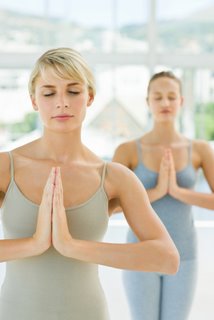 yoga Unless you’re a professional athlete, chances are you’re not getting a balanced workout during your workday. Whether you’re slaving away at a desk, making rounds, or waiting tables, you’re likely straining some muscles while ignoring others, leaving your body feeling stiff, sore, and physically exhausted. Deadlines and pressure from bosses don’t help matters, either.
“When you get stressed, you often hold your breath, which leads to holding your muscles. It feels like you’re wearing a straitjacket,” explains Elaine Petrone, a stress- and pain-management expert and creator of the “Stop the Back Pain” DVD.
You can stretch out the stress, though, with a little time and effort. “By pairing mindful stretches with deep breathing, you’ll make lasting, positive changes to the way your body works, looks, and feels,” says Petrone, who helped us develop this rejuvenating routine. Done for 15 to 20 minutes, three times a week, it paves the way to a calmer, less achy, and more energized you.
adapted from Body + Soul Magazine
Use our unique “Zen Clock” which functions as a Yoga Timer. It features a long-resonating acoustic chime that brings your meditation or yoga session to a gradual close, preserving the environment of stillness while also acting as an effective time signal. Our Yoga Timer & Clock can be programmed to chime at the end of the meditation or yoga session or periodically throughout the session as a kind of sonic yantra. The beauty and functionality of the Zen Clock/Timer makes it a meditation tool that can actually help you “make time” for meditation in your life. Bring yourself back to balance.
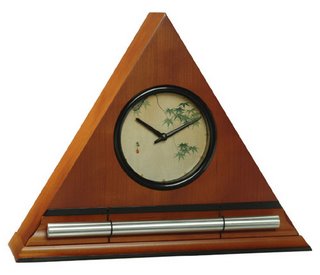 Zen Alarm Clocks and Yoga Timers with Gentle Chime Now & Zen – The Yoga Timer Store
1638 Pearl Street
Boulder, CO 80302
(800) 779-6383
Posted in Bamboo Chime Clocks, Well-being, yoga, Yoga Timer, Yoga Timers by Now & Zen, Zen Timers
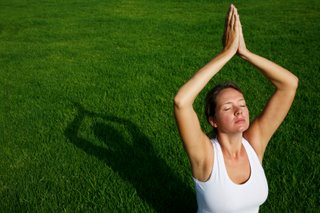 Outdoor Yoga That most familiar of asana sequences, Surya Namaskar (Sun Salutation) is as rich in symbolic and mythic overtones as it is in physical benefits.
In many cultures, light has long been a symbol of consciousness and self-illumination. “The world begins with the coming of light,” wrote Jungian analyst Erich Neumann in The Origins and History of Consciousness (Princeton University Press, 1995). “Opposition between light and darkness has informed the spiritual world of all peoples and molded it into shape.”
Our primary source of light is, of course, the sun. When we look at our closest star, we may see nothing more than a big yellow ball. But for thousands of years, the Hindus have revered the sun, which they call Surya, as both the physical and spiritual heart of our world and the creator of all life itself. That’s why one of Surya’s many other appellations is Savitri (the Vivifier), who, according to the Rig Veda, “begets and feeds mankind in various manners” (III.55.19). Moreover, since everything that exists originates from the sun, as Alain DaniŽlou wrote in The Myths and Gods of India (Inner Traditions, 1991), it “must contain the potentiality of all that is to be known.” For the Hindus, the sun is the “eye of the world” (loka chakshus), seeing and uniting all selves in itself, an image of and a pathway to the divine.
One of the means of honoring the sun is through the dynamic asana sequence Surya Namaskar (better known as Sun Salutation). The Sanskrit word namaskar stems from namas, which means “to bow to” or “to adore.” (The familiar phrase we use to close our yoga classes, namaste—te means “you”—also comes from this root.) Each Sun Salutation begins and ends with the joined-hands mudra (gesture) touched to the heart. This placement is no accident; only the heart can know the truth.
The ancient yogis taught that each of us replicates the world at large, embodying “rivers, seas, mountains, fields…stars and planets…the sun and moon” (Shiva Samhita, II.1-3). The outer sun, they asserted, is in reality a token of our own “inner sun,” which corresponds to our subtle, or spiritual, heart. Here is the seat of consciousness and higher wisdom (jnana) and, in some traditions, the domicile of the embodied self (jivatman).
It might seem strange to us that the yogis place the seat of wisdom in the heart, which we typically associate with our emotions, and not the brain. But in yoga, the brain is actually symbolized by the moon, which reflects the sun’s light but generates none of its own. This kind of knowledge is worthwhile for dealing with mundane affairs, and is even necessary to a certain extent for the lower stages of spiritual practice. But in the end, the brain is inherently limited in what it can know and is prone to what Patanjali calls misconception (viparyaya) or false knowledge of the self.
The eight basic postures, in order of performance, are Tadasana (Mountain Pose), Urdhva Hastasana (Upward Salute), Uttanasana (Standing Forward Bend), Lunge, Plank Pose, Chaturanga Dandasana (Four-Limbed Staff Pose), Urdhva Mukha Svanasana (Upward-Facing Dog Pose), and Adho Mukha Svanasana (Downward-Facing Dog Pose).
The transition from posture to posture is facilitated by either an inhalation or an exhalation. As you move through the sequence, watch your breath closely. Slow your pace or stop and rest entirely if your breathing becomes labored or shuts down altogether. Always breathe through your nose, not your mouth: Nasal breathing filters and warms incoming air and slows your breathing down, thereby lending the sequence a meditative quality and reducing the risk of hyperventilation.
To perform the sequence, start in Tadasana, with your hands together at your heart. Inhale and lift your arms overhead to Urdhva Hastasana, then exhale while lowering the arms down and fold your torso into Uttanasana. Then inhale, arch your torso into a slight backbend with the fingertips or palms pressed to the floor or blocks, and exhale while bringing your left foot back into a lunge. Inhale forward to Plank, then exhale and lower yourself into Chaturanga Dandasana. On an inhalation, arch your torso up as you straighten your arms into Upward Dog. Exhale back to Downward Dog; step the left foot forward on an inhalation into Lunge. Swing the right leg forward to Uttanasana on an exhalation, then lift your torso and reach your arms overhead on an inhalation to Urdhva Hastasana. Finally, lower your arms on an exhalation and return to your starting point, Tadasana.
Remember, this is only a half-round; you’ll need to repeat the sequence, switching left to right and right to left to complete a full round. If you’re just starting out, it might help to work on the poses individually before you put them together. (Visit www.YogaJournal.com for more how-to information.)
adapted from Yoga Journal, by Richard Rosen
Use our unique “Zen Clock” which functions as a Yoga Timer. It features a long-resonating acoustic chime that brings your meditation or yoga session to a gradual close, preserving the environment of stillness while also acting as an effective time signal. Our Yoga Timer & Clock can be programmed to chime at the end of the meditation or yoga session or periodically throughout the session as a kind of sonic yantra. The beauty and functionality of the Zen Clock/Timer makes it a meditation tool that can actually help you “make time” for meditation in your life. Bring yourself back to balance.
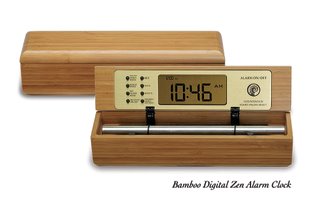 Yoga timers from Boulder, Colorado Now & Zen – The Yoga Timer Store
1638 Pearl Street
Boulder, CO 80302
(800) 779-6383
Posted in intention, Now & Zen Alarm Clocks, wake up alarm clock, Well-being, yoga, Yoga Timer, Yoga Timers by Now & Zen
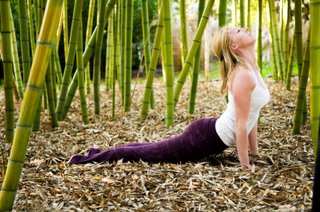 better posture from yoga Your mom was right: You’ll look better and feel great if you stop slouching and stand up straight. Yoga can help you do just that—in a way that honors your spine’s natural curves. Here’s a guide to assessing and improving your posture.
Are you a slumper? A swayer? Chances are you’re one or the other to some degree—despite Mom’s best efforts all those years ago to get you to sit up straight and stop slouching. She probably told you that you’d look and feel better if you worked on your posture, and she was absolutely right. But if you’re like most people, you rolled your eyes and ignored her, or straightened up until she wasn’t looking. And you probably didn’t give posture much more thought at all until you walked into your first yoga class and tried to stand in Tadasana (Mountain Pose).
When you’re a beginner, it’s surprisingly complicated to master the art of rooting down through the feet while lengthening up through the spine, keeping your chest open without jutting your lower ribs out, and keeping the legs muscles strong and lifted without tensing the belly or jaw. But ultimately, Tadasana demands just one simple thing: that you stand in a way that supports the natural curves of a healthy spine. So why is it so difficult? And why do we work so hard to master good posture in yoga—leaving class feeling taller and healthier—only to slump down in the car seat on the way home or revert to a swayback when we heft our overstuffed yoga bags onto our backs?
In short, modern life conspires against good posture. We spend our days sitting at desks, staring at computer screens. When we travel, we do it in cars or—worse—airplanes. We lounge around in overstuffed chairs designed more for looks than for lumbar support. And we pay people to mow our lawns, tend our gardens, and remove our trash so we can spend more time working or driving or sitting. Nonsedentary cultures—with a few exceptions—don’t have the same epidemic of back and neck problems that we do. Picture a woman gracefully balancing a large basket of food on her head. To carry such a heavy weight, she must have a perfectly aligned spine and strong posture-support muscles. You don’t get that kind of alignment and strength from sitting around and watching the tube. You can, however, get it from a regular yoga practice.
Take comfort in knowing that yoga trains your mind as well as your body. As you continue to devote yourself to your practice, you will become more present in your body and more aware of your alignment, and you will begin to naturally make choices that will improve your health and your quality of life. Over time, the combination of increased awareness and physical training will allow your improved alignment to spill out into other areas of your life. Before you know it, you’ll feel at ease as you practice good yoga alignment while you’re perched at your desk, standing at the copier, and sitting at dinner. You’ll be doing yoga during all of your waking hours. And who knows? You might just impress your mom!
adapted fromYoga Journal, by Julie Gudmestad
Use our unique “Zen Clock” which functions as a Yoga Timer. It features a long-resonating acoustic chime that brings your meditation or yoga session to a gradual close, preserving the environment of stillness while also acting as an effective time signal. Our Yoga Timer & Clock can be programmed to chime at the end of the meditation or yoga session or periodically throughout the session as a kind of sonic yantra. The beauty and functionality of the Zen Clock/Timer makes it a meditation tool that can actually help you “make time” for meditation in your life. Bring yourself back to balance.
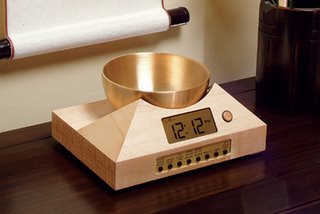 Zen Timepiece, a yoga timer and clock with Tibetan bowl Now & Zen – The Yoga & Meditation Timer Store
1638 Pearl Street
Boulder, CO 80302
(800) 779-6383
Posted in intention, Well-being, yoga, Yoga Timer, Yoga Timers by Now & Zen, Zen Timers
 ume tree (japanese blum) Kaisan-do of Ryodaishi temple Train yourself to reflect before you buy something. Why do you want it? Do you really need it, or are you trying to escape negative emotions? Yoga can help you do without retail therapy, Main says: “The word asana means ‘sit’ … Yoga teaches us to sit with uncomfortable physical sensations, to breathe and relax into them. So when a negative emotion arises, instead of trying to bury it under a new pair of shoes or an iPod or whatever, let it bubble to the surface, look at it, and let it go.” Davis says her yoga practice of 14 years helps her stick to the Compact. “Yoga makes you deal with what’s really going on inside, instead of medicating it through shopping.”
Luhrs says she loves clothes but not as much as she loves the freedom of being debt free. In order to avoid running up credit card bills, she asks herself five questions before buying anything: “Do I have the cash to pay for it? Do I have room in my closet for this outfit? Do I want another outfit? Do I want to care for more clothes? Will I really wear this item a lot? ” You can run through a similar checklist of questions whenever you’re considering buying something new. If it’s an item for the home, Luhrs suggests, “Ask yourself if your eyes need one more thing to look at, or would they rather rest in open space?”
Of course, after reflection, you may decide that you genuinely need something. Before you buy it new, consider alternatives. Can you mend yours? Can you borrow it? Can you buy it used? The obvious places to look for secondhand stuff are thrift stores, garage sales, and secondhand furniture stores. But you can also try craigslist or Freecycle, a network of local groups whose members give each other unwanted items. In San Francisco, Compacters use Building REsources for salvaged architectural material like windows and doorknobs, and SCRAP (Scroungers’ Center for Reusable Art Parts) for low-cost fabric and art supplies. You may be able to find similar resources in your area.
adapted from Yoga Journal, by Helena Echlin
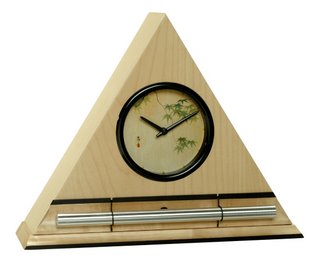 Maple Leaves Dial Face, Zen Alarm Clock with Maple Finish Now & Zen
1638 Pearl Street
Boulder, CO 80302
(800) 779-6383
Posted in intention, wake up alarm clock, Well-being, yoga, Zen Timers
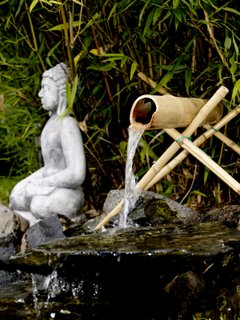 When less is more Make more time for doing the things you love by simplifying your life.
Judy Davis never buys anything new if she can help it. A 58-year-old freelance marketing consultant who lives in Red Bluff, California, she favors thrift store clothing and secondhand furniture. Instead of buying gifts, she gives plants from her garden or bags she has sewn from cut-up vintage gowns. Judy is part of a Bay Area group called the Compact. The Compacters have vowed not to buy anything new for a year except bare essentials: food, medicine, cleaning products, and underwear (although not, of course, lingerie from Paris). Although few people take frugality quite as seriously as the Compacters do, more and more of us are voluntarily cutting back on buying and consumption. Many individuals choosing this lifestyle happen to be yogis. The seminal work of yoga philosophy, Patanjali’s Yoga Sutra, frowns on materialism, and some yogis find that their asana practice alone helps them be happier with less.
The pursuit of the simple life is nothing new, of course. From Quakers to Transcendentalists, America has always had its share of those who associate simplicity with spiritual growth. Back-to-the-land hippies of the ’60s and ’70s found simplicity appealing for more secular reasons, such as ecological sustainability. But those who practice pared-down living today are not necessarily spiritual ascetics or off-the-grid granola types. Most are ordinary people modifying their everyday behavior-trying to be conscious about what they eat, drive, and buy.
In the past 15 years, “voluntary simplicity,” as it is called, has gained thousands of converts. Many books on the subject have been published, such as Janet Luhrs’s The Simple Living Guide, Cecile Andrews’s Circle of Simplicity: Return to the Good Life, and Linda Breen Pierce’s Choosing Simplicity: Real People Finding Peace and Fulfillment in a Complex World. Dozens of websites have sprung up, and nonprofits like Seeds of Simplicity and Simple Living America champion the cause. When the Compacters publicized their manifesto in January 2006, their Yahoo group swelled from about 50 in February to 1,225 in July, with members across America.
Most spiritual traditions encourage simple living, and yoga is no exception. In the Yoga Sutra, Patanjali laid out the yamas (moral restraints) and niyamas (observances), a set of 10 principles that are crucial to one’s progress along the yogic path. One of the yamas is aparigraha, often translated as “greedlessness.” But it means more than just taking only what you need, explains David Frawley, founder and director of the American Institute of Vedic Studies and author of Yoga and the Sacred Fire. Aparigraha also means “not having a lot of unnecessary things around yourself and not hankering after what other people have,” Frawley says. In other words, aparigraha also means keeping only what you need and wanting only what you need.
Aparigraha leads naturally to one of the niyamas: santosha, or “contentment,” being satisfied with the resources at hand and not desiring more. Ultimately, Frawley says, “Yoga is about transcending the desire for external things, which is the cause of suffering, and finding peace and happiness within.”
adapted from Yoga Journal, by Helena Echlin
 Zen Alarm Clocks Now & Zen
1638 Pearl Street
Boulder, CO 80302
(800) 779-6383
Posted in intention, Meditation Timers, Meditation Tools, mindfulness practice, Now & Zen Alarm Clocks, Well-being, zen, Zen Alarm Clock, Zen Timers
 Healing Gems In this relaxing ritual, you’ll gather stones to stimulate the body’s seven main energy centers, or chakras, in the Ayurvedic tradition. While many massage therapists use large stones to massage out tension in muscles, simply placing stones at strategic points on the body can encourage relaxation.
On a sunny day, take a stroll along the beach to gather seven dark-colored, smooth, round stones, preferably 1 or 2 inches in diameter. Set your Zen Timer to 15 minutes. Set them down in a sunny spot and allow them to warm up for 10 to 15 minutes. When you’re ready, lie flat on your back and place a stone on each of the seven chakras (see Vital Energy Centers), one by one. Let your body relax and sink into the ground; feel the weight of each stone and the sensation it creates on your skin. Visualize energy radiating from each chakra through your body, from the top of your head through your toes. Set your Zen Timer for 20 minutes. Relax for about 20 minutes, and then remove the stones.
adapted from Body + Soul, July/August 2006
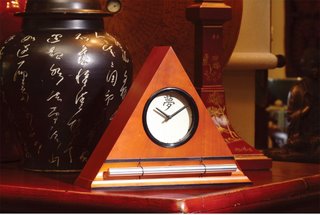 Zen Timers Now & Zen
1638 Pearl Street
Boulder, CO 80302
(800) 779-6383
Posted in intention, Meditation Timers, mindfulness practice, Now & Zen Alarm Clocks, Well-being, Zen Alarm Clock, Zen Timers
 pamper your feet Cold feet are one of winter’s most annoying — and common — afflictions. The answer? A rich blend of warm, wintry spices. Cayenne, cinnamon, and ginger are all circulation boosters and mild stimulants. Applied topically, they increase blood flow, relieving chill and numbness. Cayenne, in particular, has foot-warming benefits; folk wisdom suggests sprinkling the fiery pepper into socks on cold days. For a more luxurious experience, try this simple foot mask. It combines spices, skin-soothing ingredients such as oatmeal and honey, and the invigorating essence of orange.
Orange Spice Foot Mask
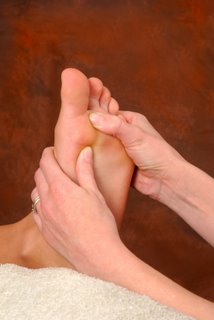 cure cold feet 1/2 cup whole oats
1/2 teaspoon cinnamon
1/2 teaspoon cayenne pepper
4 tablespoons warm water
1 teaspoon olive oil
1 tablespoon honey
1 tablespoon fresh ginger, grated
4 drops sweet orange essential oil
Food Mask How-To
1. Using a food processor, grind the oats to a fine powder. Transfer to a medium-size bowl, add the remaining ingredients, and stir until blended into a thick paste.
2. Prepare two warm, wet washcloths or hand towels, either by wetting them and placing them in the microwave for one to two minutes or by soaking them in hot (not boiling) water. Wring out excess water and set aside.
3. Sitting with your feet in the tub or a large basin, use your hands to spread a thick layer of the mask over each foot, covering them completely up to the ankles. After wiping hands clean, wrap each foot in one of the washcloths to seal in the moisture from the mask. Set your Zen Timer for 15 minutes. Set your Zen Timer with Bowl. Sit back and relax for 10 to 15 minutes.
4. When you’re ready to remove the mask, carefully lift off the washcloths. Rinse your feet thoroughly using warm water. Pat dry with a towel.
adapted from Body + Soul Magazine, Jan/Feb 2006 by Donna Garlough
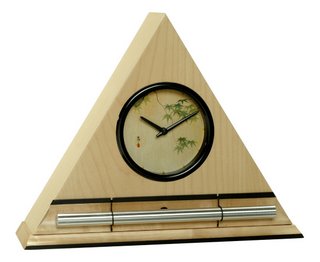 Zen Alarm Clock with Maple Leaves Now & Zen
1638 Pearl Street
Boulder, CO 80302
800) 779-6383
Posted in Chime Alarm Clocks, Well-being, Zen Alarm Clock, Zen Timers
 do it yourself facial Massaging Your Face
This is a great way to loosen muscles scrunched into habitual expressions. “This brings blood to the surface, clears out puffiness, and reduces fatigue in the skin,” says Chris Haas, owner of Ra Organic Spa in Burbank, California. Don’t have time for an appointment? At home, all you need is the following ingredients for a facial serum. Barbara Close, founder of Naturopathica, recommends a base of evening primrose and avocado oils with rose geranium, lavender, and German chamomile essential oils for dry skin, or apricot kernel oil with juniper, lemon, and rosemary oils for oily skin. How? Starting at the chin, move your hands in small circles and continue to the cheeks, around the eyes, and to the forehead. By doing this, you’re stimulating circulation and bringing more nutrients to the skin. Follow with a warm compress to increase the absorption of the serum. Here are some DIY recipes for facial serum, based on your type of skin:
For Dry Skin
Ingredients
1-ounce bottle
1/2 ounce avocado oil
1/2 ounce evening primrose oil
6 drops rose geranium essential oil
3 drops lavender essential oil
2 drops German chamomile
Directions
Fill bottle halfway with avocado oil. Add essential oils, cap bottle, and shake well. Top off with half ounce of evening primrose oil and shake again.
For Oily Skin
Ingredients
1-ounce bottle
1/2 ounce apricot oil
1/2 ounce hazelnut or jojoba oil
6 drops rosemary essential oil
3 drops juniper essential oil
4 drops neroli essential oil
Directions
Fill bottle halfway with apricot oil. Add essential oils, cap bottle, and shake well. Top off with half ounce of hazelnut or jojoba oil and shake again.
For Sensitive Skin
Ingredients
1-ounce bottle
1/2 ounce jojoba oil
1/2 ounce rosehip seed oil
3 drops everlasting essential oil
2 drops German chamomile
6 drops rose geranium essential oil
Directions
Fill bottle halfway with jojoba oil. Add essential oils, cap bottle, and shake well. Top off with half ounce of rosehip seed oil and shake again.
adapted from Body + Soul, October 2010
 Chime Timers and Clocks with Chime in Bamboo, Walnut, Maple, and Black Lacquer Now & Zen
1638 Pearl Street
Boulder, CO 80302
(800) 779-6383
Posted in Chime Alarm Clocks, intention, mindfulness practice, Well-being, Zen Alarm Clock, Zen Timers
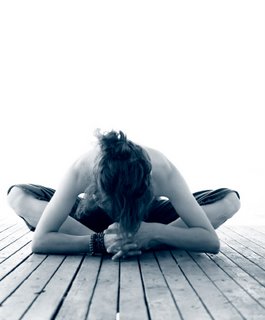 what energizes me? Universal fixes help, but managing your energy levels can also be a very personal process. Here’s what some whole-living luminaries do to recharge:
“To paraphrase Thoreau, my tonic is the wilderness. When I am low on energy, I go to nature, and it restores me every time. Whether I’m sitting next to a lake or canoeing in it, just being in a place where plants thrive feeds my energy.”
–Rosemary Gladstar, herbalist, teacher, and founder of United Plant Savers
“Doing deep yogic breathing, Sun Salutations to fun and upbeat rock music, and inverted poses like handstands get me going. Plus, I conserve my energy and redeploy it into the priorities of what must be done, cutting out all extraneous activities, like internal dialogue (negative and overwhelming banter), anger, frustration, and fears.”
–Ana Forrest, yoga pioneer and creator of Forrest Yoga
“My dogs walk me twice a day, and they’re the best energizer I know. There’s nothing like getting out in nature with two joyous beasts who don’t have to think twice about the meaning of unconditional love, both for me and the trail, however well beaten a track it is.”
–Kenny Ausubel, founder of the Bioneers Conference and co-executive director of the Collective Heritage Institute
 wilderness is a tonic “A frothy cup of green matcha tea and some breathing exercises help get me energized, as does an invigorating swim in my pool. Plus, looking forward to something with excitement always motivates me.”
–Andrew Weil, M.D., author of “Healthy Aging” and editor of Dr. Andrew Weil’s Self Healing Newsletter
“I love my work and get pulled in by endless to-do’s, often chugging along until I’m exhausted and ‘too-done.’ While exercise, yoga, and meditation help keep my energy high, so do regular breaks from the usual routine. I keep my knitting bag, beading box (I love to make malas and prayer bracelets as gifts), and a fast-paced mystery novel handy for 10- to 15-minute breaks three or four times a day. Letting go of responsibility to bask in creativity, or to drop into a fictional world very different from my own, keeps the juices flowing.”
–Joan Borysenko, Ph.D., psychologist and best-selling author of 12 books, including “Saying Yes to Change”
adapted from Body + Soul, September 2006
 Bamboo Zen Timer and Natural Alarm Clock with Gentle Chime Now & Zen
1638 Pearl Street
Boulder, CO 80302
(800) 779-6383
Posted in intention, Meditation Timers, Meditation Tools, mindfulness practice, nature, Walking Meditation, Well-being, zen
 Stress Cures From traffic jams to lost luggage, holiday travel can leave you frazzled. This year, get the holidays off to a stress-free start by arriving at your final destination composed and energized. Just follow these simple tips from Kate Hanley, author of The Anywhere, Anytime Chill Guide.
Stretch It Out
Where stress starts, tight muscles follow. Ease the strain of hours sitting in the sky or on the road with a simple, seated stretch Hanley calls The Number Four: Place an ankle over the opposite knee (making the shape of a four) then lean forward and rest your elbows on your shin.
Apply Pressure
If icy roads or midflight turbulence leave you with a pounding heart and racing thoughts, Hanley recommends a little acupressure. Simply curl each finger down until it touches the palm. The subtle move lessens anxiety by slowing down the heart and, in turn, quieting the mind.
Say It Out Loud
“The very act of traveling requires an element of surrender,” says Hanley. When plans go awry (a delayed flight, a missed exit) — and they will — slowly repeat the mantra “I’ll get there when I get there.” This helps you stay mindful of what’s out of your control.
Wish Them Well
With everyone rushing to get from point A to point B, you’re guaranteed to run in to someone who will ruffle your feathers. “The trick to not losing your cool,” says Hanley, “is to develop compassion.” Instead of flying off the handle at that impatient driver or curt customer service rep, try a kindness meditation. Hold an image of them in your mind and put yourself in their shoes with an empathetic thought: “I’m sure he’s anxious to see his family” or “I bet she’s had a long day.”
adapted from Body + Soul November 2009
 Zen Timer for your wellbeing practice Now & Zen
1638 Pearl Street
Boulder, CO 80302
(800) 779-6383
Posted in Chime Alarm Clocks, intention, Meditation Timers, Meditation Tools, mindfulness practice, Now & Zen Alarm Clocks, Well-being, Zen Timers
« Previous Page — « Previous Entries
Next Entries » — Next Page »
|
|
|
|